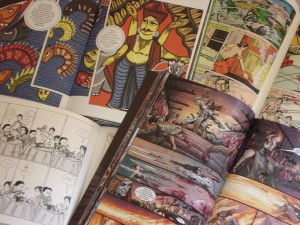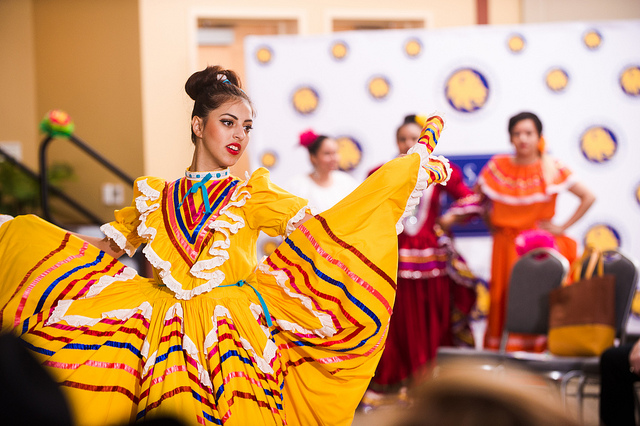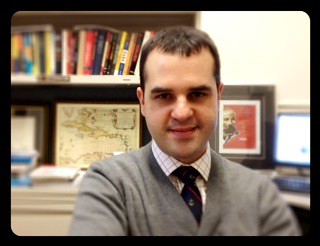I recently sat down with Mara Thacker, the Library’s South Asian Studies Librarian, to talk with her about one of the Library’s newest collections, the South Asia Comic Collection. The South Asia comics are “part of an initiative to develop a national specialized research resource for students, instructors, and scholars interested in these materials… [It] expands on the Library’s existing popular culture collection.” [i] The following post is an edited version of our interview.

Clockwise from top Right: Samhita Arni and Moyna Chitrakar’s “Sita’s Ramayana,” Amar Chitra Katha’s “Mahabharata,” Shekhar Kapur’s “Devi vol. 2,” and Manjula Padmanabhan’s “Double Talk.”
When did the Library begin to collect South Asian comics? And why did you begin the collection?
This is a new project we declared in October 2012. We participate in a cooperative acquisitions program [ii] with the other South Asia librarians and people that participate in our professional organization. This past year, the project was to identify an area of specialization, declare that for your university, and commit to collecting these materials and to the that it is possible making them available. When I was looking at options for what Illinois could specialize in, comics seemed like a good choice because David Ward, in the Undergraduate Library, had approached me about Indian comics and as I investigated things I realized that there were not a lot of holdings in the U.S. that seemed to be easily available. I realized that it was an area that was really under collected on a national level, there was somebody who could partner [and] provide an extra little financial incentive, and also something niche enough that I think we could fully cover and start from the beginning.
Was the tie in the Undergraduate’s comic collection one of the main factors for why you started this collection?
It was certainly helpful. When you are picking an area of specialization like that, you have a lot of freedom to pick something that interests you and that you think is fun. I have a little bit of back ground in visual culture and popular culture studies, so I think comics are fascinating and a growing area of interests in the academy. But I had to have something that was budgetarily feasible, so having a partnership with the Undergraduate Library, knowing that there is a place for this collection to be housed, certainly helped. And if David Ward and the Undergraduate Library had said, ‘No, we can’t deal with the volume of this,’ or ‘No, we’re not interested,’ then I don’t know that I would have proceeded.
How big is the collection right now? Have you started collecting?
The comic industry in India is not huge. As I said that was one reason we selected that as an area because we could do some retrospective collecting and get a fair portion of what’s available. What we have so far, or most of what we have, I got on a buying trip to India. I went in January to February 2013, and I actually went to Comic Con in New Delhi and bought everything that was available, which wasn’t as much as you would think. I was also at the Delhi book fair and I bought the full run of Amar Chitra Katha comics. Actually, those are pretty widely held; they’re the one sort of anomaly of Indian comics, … but for some of the other comics, like Raj Comics and Diamond Comics, to name a few, they’re not necessarily widely available, so I picked up whatever was available at the book fair.
We have 371 Amar Chitra Katha comics from the buying trip, never mind what we may have already had. The 173 titles form Raj Comics, those are mostly in Hindi. We have 85 from miscellaneous publishers; those are often one-off graphic novels. And then we have 30 from Diamond Comics. There are a couple other publishers and character series that we hope to pick up as we go along.
So roughly 500 or so?
More than. I think just over 600. And we did have some stuff already that has come in over the years from other places, mostly graphic novels.
The comics that were already here, are you going to try to move them into the collection, house them all together? Or is it going to be spread out across the University libraries?
I haven’t decided if I’m going to move things that we have already bought or if it’s going to be moving forward a new policy. I know that everything we bought, starting in October, is going to go in the Undergraduate Library graphic novel and comic collection. We have talked about if we get some older comics and some rare comics, you know from the 60s, 70s, or earlier, it may be more appropriate to put them in Rare Books. But I’m not sure if it would be a mountain of work to try to identify everything that’s elsewhere and move it. That’s a decision to be made later.
We talked a little bit about what is in the collection already. You mentioned the Amar Chitra Katha Comics and those from Raj and Diamond, are they mainly graphic novels? Are they superhero comics? Are they political cartoons and comic strips? Are they all of the above?
All of the above. Raj Comics are superhero comics mostly. The Diamond Comics are more like the Archie and Jughead kind of thing in the sense that they are sort of family friendly and cutesy, but still on that pulpy paper. But then we’ve gotten quite a few graphic novel comics from Pop Cracker and Campfire, and those are more along the lines of Neil Gaiman and those sorts of U.S.-based graphic novels.
You mentioned before that some of the Raj Comics are in Hindi, are there other languages besides English and Hindi in the collection?
Right now just English and Hindi. We will expand to other languages as it becomes possible. The Amar Chitra Katha comics are available in a ton of the different languages of India and I think they could come with the cataloging done. But one of our issues is that we don’t have a huge amount of South Asian language expertise in cataloging right now. So processing things in languages other than English is more challenging. Even the Hindi is challenging, we just have a temporary person helping with that. And they’re not really in WorldCat, which is a problem.
Are you limiting the collection only to India for right now? Are you going to expand to other South Asian countries?
Hopefully, we can expand. I don’t know how big the comic industry is in other countries. I met a librarian from Pakistan that I asked about comics and I don’t think the industry is as large as it is in India, which is still a relative term, because compared to East Asia and the U.S. comics are still pretty small. It would be nice to have comics from all of the South Asian countries but India was sort of the low hanging fruit for a starting point.
How does the comic collection fit in with the rest of the South Asian collection?
In terms of popular culture items, we do have a pretty decent popular film collection for South Asia, mostly India and mostly Hindi, but also the other languages of India. So I think it fits in well in that regard and we also collect South Asian literature. Comics are that interesting middle ground between visual artifacts and textual artifacts so it fits in with the other things that we collect more generally in that way.
I know the Libguide gives a list of subject terms to search in the catalog, but it’s a little difficult to find them sometimes. Are you going to have some sort of designator especially for the Indian comics so that users can browse through them in the catalog?
I don’t know what subject term we would use. We talked about having some sort of subject or some sort of tag, but we’re not at that phase yet. Actually, all of this is taking a bit longer than I expected.
I just asked because when I was looking, I used, or tired to use, the subject terms from the Libguide and it was hard to find them.
Well most of them aren’t in there yet. Actually, nothing from the buying trip is in the catalog yet. I went to India, bought everything they had, brought it back, and realized that we have to get it into the catalog and they’re not in WorldCat. There is probably going to be some original cataloging involved. I’m not a cataloger, but other people don’t necessarily have the South Asia expertise, so it’s [difficult] trying to figure out how to make this collection findable. Luckily we had some protocols, as they figured things out through trial and error setting up the the graphic novel and comic collection for the English language materials, so we’ve been able to use that as a model, but we’ve also had to make specific decisions about the way these things should be grouped together.
Do you have a date that they might be available? Because until they’re in the catalog, users can’t access them, right?
We were hoping to have them out sometime in the Fall semester. I don’t know if that is going to happen. Once we give them [Cataloging] the instructions, that’s all well and good, but there’s still no one down there who speaks Hindi. I’m hoping that we can be pleasantly surprised, but it’s a lot of work to have sprung on them.
So changing tracks here, what kind of comics are you most interested in?
I enjoy the re-tellings of the Indian myths. The Devi comics were one of the ones I looked at when I was starting to kind of dip my toe in. I really like the artwork for those; they’re so aesthetically fun. I enjoy those and I think the Amar Chitra Katha and probably the Raj too. The language is a bit easier, the Hindi language, than it would be in a novel, so I think as a student of Hindi I enjoy those to try to improve my language skills. And I hope at some point I can get some of the Hindi students here to discover them.
What are your overall plans for the collection? Do you want to get every single Indian comic out there? Or do you just want to get the big ones and some of the more specialized comics?
Well, at this point, I think that the industry is small enough that it would be feasible to get almost everything. The retrospective stuff is going to be more challenging, at least in terms of getting complete sets. We’ve got all those Raj comics titles; I asked them for a complete set and … they handed me these giant bundles. I get them back [to the U.S.] and start going through them and I realize that they’re not complete when you look at the sequencing for the numbers. But … that was what they had. What I don’t know is how to get my hands on the things that weren’t included in those bundles. So the retrospective stuff, I anticipate being tricky. If there was a collector in India that would like bestow their collection from their childhood upon us that would be a miracle, but I don’t think that is going to happen.
Any other big plans for the collection? Do you want to start including them in the Hindi classes, like you mentioned earlier?
I think that would be pretty cool. I also think it would be interesting if we became a destination for people who are doing research in popular and visual culture. If they came here to use our comics or if we were able to send them through inter-library loan. I’ve been toying with the idea of inviting a speaker or doing some sort of event centered around the collection.
Having Hindi students be aware of it would be great. Having visual and popular culture scholars be aware of it would be great. But part of it too is that fact that, from what I can tell in all of my research, these things have not been comprehensively collected anywhere in North America. Different libraries have different pieces of things, but this is something that in terms of … the national collection, I think it’s an important contribution. Because other than Amar Chitra Katha, they just haven’t been collected and made accessible.
And I don’t think that it’s being done in India either. I think as with other types of popular culture items, it takes awhile to get the respect, I guess. I think comic studies and visual culture studies is pretty legitimate within the academy, but still I don’t think people think to hold onto and preserve and collect these things. Since comic culture isn’t as big in India as it is in Japan, or even Korea and China; I think it just hasn’t been collected.
If someone wanted to start reading Indian comics, where would you suggest they start? Is there any source material you would show them? Or just point them to the Libguide?
The Libguide would be a good starting point, because that will give you a pretty wide range of whatever is there. There is a graduate assistant at the Undergraduate Library who did some pretty deep searching and I did a lot of searching, too. Then together we put together as much of a bibliography as we could. Again there is not a lot out there, but there should be some good starting points there.
Any other points you want to highlight about the collection?
Just that I hope it will be available sooner rather than later. It’s been a very complex project. It’s started with ‘wouldn’t it be great if…’ and now it’s a lot of work. So it’s not all fun and games with a comic collection.
[i] South Asia Comic Collection. Libguide. http://uiuc.libguides.com/southasiancomics
[ii] South Asia Cooperative Collection Development Initiative. 2012 Summary Report and Outcomes. http://www.library.wisc.edu/guides/SoAsia/2012Report.pdf







